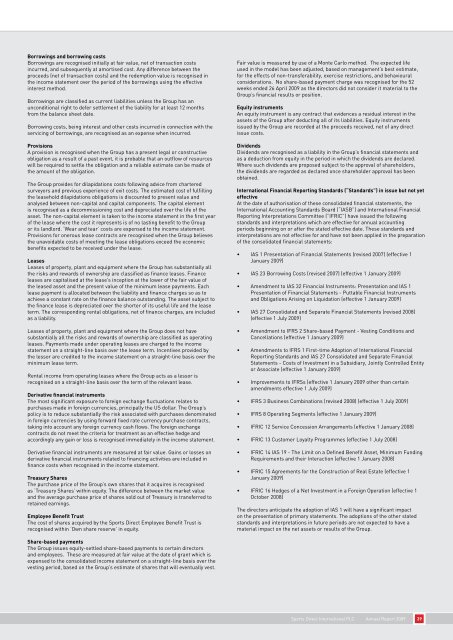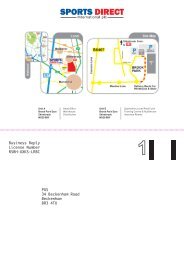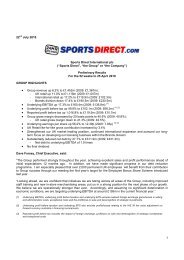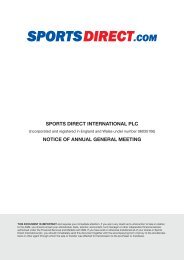Sports Direct Is The UK's Leading Sports Retailer - Sports Direct ...
Sports Direct Is The UK's Leading Sports Retailer - Sports Direct ...
Sports Direct Is The UK's Leading Sports Retailer - Sports Direct ...
Create successful ePaper yourself
Turn your PDF publications into a flip-book with our unique Google optimized e-Paper software.
Borrowings and borrowing costs<br />
Borrowings are recognised initially at fair value, net of transaction costs<br />
incurred, and subsequently at amortised cost. Any difference between the<br />
proceeds (net of transaction costs) and the redemption value is recognised in<br />
the income statement over the period of the borrowings using the effective<br />
interest method.<br />
Borrowings are classified as current liabilities unless the Group has an<br />
unconditional right to defer settlement of the liability for at least 12 months<br />
from the balance sheet date.<br />
Borrowing costs, being interest and other costs incurred in connection with the<br />
servicing of borrowings, are recognised as an expense when incurred.<br />
provisions<br />
A provision is recognised when the Group has a present legal or constructive<br />
obligation as a result of a past event, it is probable that an outflow of resources<br />
will be required to settle the obligation and a reliable estimate can be made of<br />
the amount of the obligation.<br />
<strong>The</strong> Group provides for dilapidations costs following advice from chartered<br />
surveyors and previous experience of exit costs. <strong>The</strong> estimated cost of fulfilling<br />
the leasehold dilapidations obligations is discounted to present value and<br />
analysed between non-capital and capital components. <strong>The</strong> capital element<br />
is recognised as a decommissioning cost and depreciated over the life of the<br />
asset. <strong>The</strong> non-capital element is taken to the income statement in the first year<br />
of the lease where the cost it represents is of no lasting benefit to the Group<br />
or its landlord. ‘Wear and tear’ costs are expensed to the income statement.<br />
Provisions for onerous lease contracts are recognised when the Group believes<br />
the unavoidable costs of meeting the lease obligations exceed the economic<br />
benefits expected to be received under the lease.<br />
leases<br />
Leases of property, plant and equipment where the Group has substantially all<br />
the risks and rewards of ownership are classified as finance leases. Finance<br />
leases are capitalised at the lease’s inception at the lower of the fair value of<br />
the leased asset and the present value of the minimum lease payments. Each<br />
lease payment is allocated between the liability and finance charges so as to<br />
achieve a constant rate on the finance balance outstanding. <strong>The</strong> asset subject to<br />
the finance lease is depreciated over the shorter of its useful life and the lease<br />
term. <strong>The</strong> corresponding rental obligations, net of finance charges, are included<br />
as a liability.<br />
Leases of property, plant and equipment where the Group does not have<br />
substantially all the risks and rewards of ownership are classified as operating<br />
leases. Payments made under operating leases are charged to the income<br />
statement on a straight-line basis over the lease term. Incentives provided by<br />
the lessor are credited to the income statement on a straight-line basis over the<br />
minimum lease term.<br />
Rental income from operating leases where the Group acts as a lessor is<br />
recognised on a straight-line basis over the term of the relevant lease.<br />
derivative financial instruments<br />
<strong>The</strong> most significant exposure to foreign exchange fluctuations relates to<br />
purchases made in foreign currencies, principally the US dollar. <strong>The</strong> Group’s<br />
policy is to reduce substantially the risk associated with purchases denominated<br />
in foreign currencies by using forward fixed rate currency purchase contracts,<br />
taking into account any foreign currency cash flows. <strong>The</strong> foreign exchange<br />
contracts do not meet the criteria for treatment as an effective hedge and<br />
accordingly any gain or loss is recognised immediately in the income statement.<br />
Derivative financial instruments are measured at fair value. Gains or losses on<br />
derivative financial instruments related to financing activities are included in<br />
finance costs when recognised in the income statement.<br />
treasury shares<br />
<strong>The</strong> purchase price of the Group’s own shares that it acquires is recognised<br />
as ‘Treasury Shares’ within equity. <strong>The</strong> difference between the market value<br />
and the average purchase price of shares sold out of Treasury is transferred to<br />
retained earnings.<br />
employee Benefit trust<br />
<strong>The</strong> cost of shares acquired by the <strong>Sports</strong> <strong>Direct</strong> Employee Benefit Trust is<br />
recognised within ‘Own share reserve’ in equity.<br />
share-based payments<br />
<strong>The</strong> Group issues equity-settled share-based payments to certain directors<br />
and employees. <strong>The</strong>se are measured at fair value at the date of grant which is<br />
expensed to the consolidated income statement on a straight-line basis over the<br />
vesting period, based on the Group’s estimate of shares that will eventually vest.<br />
Fair value is measured by use of a Monte Carlo method. <strong>The</strong> expected life<br />
used in the model has been adjusted, based on management’s best estimate,<br />
for the effects of non-transferability, exercise restrictions, and behavioural<br />
considerations. No share-based payment charge was recognised for the 52<br />
weeks ended 26 April 2009 as the directors did not consider it material to the<br />
Group’s financial results or position.<br />
equity instruments<br />
An equity instrument is any contract that evidences a residual interest in the<br />
assets of the Group after deducting all of its liabilities. Equity instruments<br />
issued by the Group are recorded at the proceeds received, net of any direct<br />
issue costs.<br />
dividends<br />
Dividends are recognised as a liability in the Group’s financial statements and<br />
as a deduction from equity in the period in which the dividends are declared.<br />
Where such dividends are proposed subject to the approval of shareholders,<br />
the dividends are regarded as declared once shareholder approval has been<br />
obtained.<br />
international financial reporting standards (“standards”) in issue but not yet<br />
effective<br />
At the date of authorisation of these consolidated financial statements, the<br />
International Accounting Standards Board (“IASB”) and International Financial<br />
Reporting Interpretations Committee (“IFRIC”) have issued the following<br />
standards and interpretations which are effective for annual accounting<br />
periods beginning on or after the stated effective date. <strong>The</strong>se standards and<br />
interpretations are not effective for and have not been applied in the preparation<br />
of the consolidated financial statements:<br />
• IAS 1 Presentation of Financial Statements (revised 2007) (effective 1<br />
January 2009)<br />
• IAS 23 Borrowing Costs (revised 2007) (effective 1 January 2009)<br />
• Amendment to IAS 32 Financial Instruments: Presentation and IAS 1<br />
Presentation of Financial Statements - Puttable Financial Instruments<br />
and Obligations Arising on Liquidation (effective 1 January 2009)<br />
• IAS 27 Consolidated and Separate Financial Statements (revised 2008)<br />
(effective 1 July 2009)<br />
• Amendment to IFRS 2 Share-based Payment - Vesting Conditions and<br />
Cancellations (effective 1 January 2009)<br />
• Amendments to IFRS 1 First-time Adoption of International Financial<br />
Reporting Standards and IAS 27 Consolidated and Separate Financial<br />
Statements - Costs of Investment in a Subsidiary, Jointly Controlled Entity<br />
or Associate (effective 1 January 2009)<br />
• Improvements to IFRSs (effective 1 January 2009 other than certain<br />
amendments effective 1 July 2009)<br />
• IFRS 3 Business Combinations (revised 2008) (effective 1 July 2009)<br />
• IFRS 8 Operating Segments (effective 1 January 2009)<br />
• IFRIC 12 Service Concession Arrangements (effective 1 January 2008)<br />
• IFRIC 13 Customer Loyalty Programmes (effective 1 July 2008)<br />
• IFRIC 14 IAS 19 - <strong>The</strong> Limit on a Defined Benefit Asset, Minimum Funding<br />
Requirements and their Interaction (effective 1 January 2008)<br />
• IFRIC 15 Agreements for the Construction of Real Estate (effective 1<br />
January 2009)<br />
• IFRIC 16 Hedges of a Net Investment in a Foreign Operation (effective 1<br />
October 2008)<br />
<strong>The</strong> directors anticipate the adoption of IAS 1 will have a significant impact<br />
on the presentation of primary statements. <strong>The</strong> adoptions of the other stated<br />
standards and interpretations in future periods are not expected to have a<br />
material impact on the net assets or results of the Group.<br />
<strong>Sports</strong> <strong>Direct</strong> International PLC Annual Report 2009 39



![Our ref: [ ] - Sports Direct International](https://img.yumpu.com/19248141/1/184x260/our-ref-sports-direct-international.jpg?quality=85)






![Our ref: [ ] - Sports Direct International](https://img.yumpu.com/18440214/1/184x260/our-ref-sports-direct-international.jpg?quality=85)
